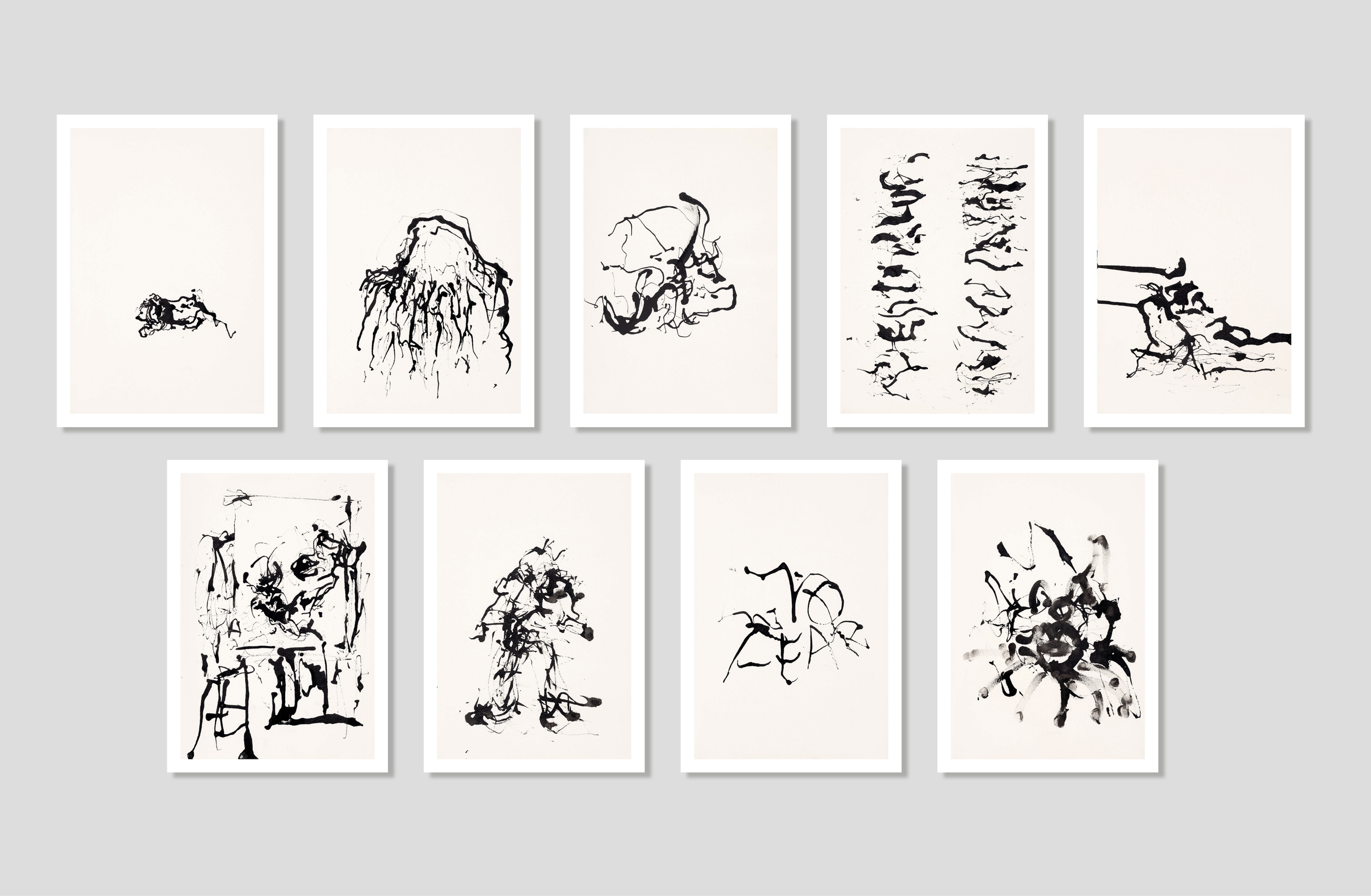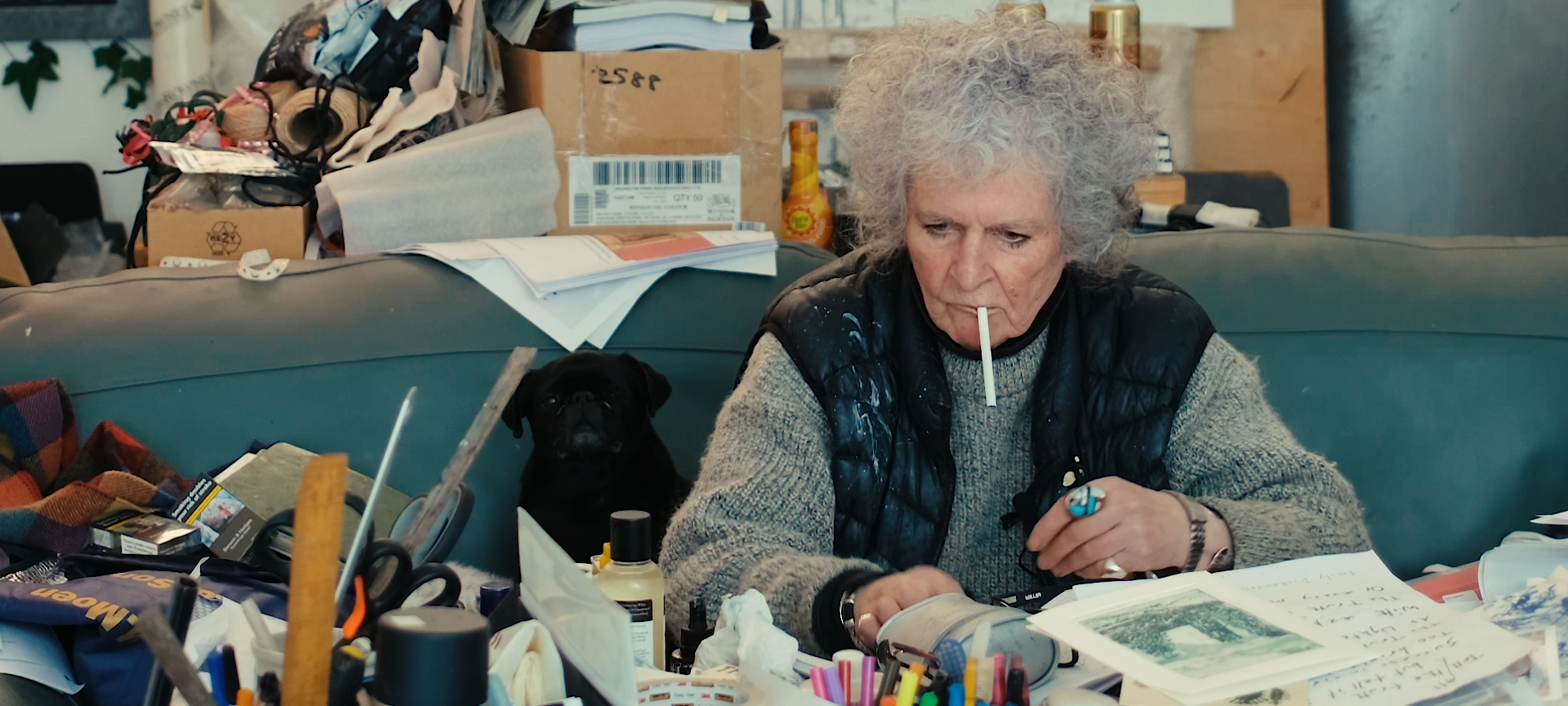Maggi Hambling
6am
The story of ‘6am’
Maggi Hambling 6am is a group of nine drawings, bearing witness to a daily act. An early riser, Hambling starts each day in the studio with a drawing – applying black ink straight from the dropper of the bottle onto a blank page. The ink hits the paper in unrepeatable, inerasable formations. The results are unpremeditated, like thoughts still forming – sometimes cohering, often remaining indeterminate. Typically, the marks vary in density and tempo, from black rivulets to flickering impressions. “It’s all experiment,” she has stated. “Everything just happens.” In her desire to allow things to happen, she surrenders control – drawing with her ‘untrained’ left hand and sometimes closing her eyes. The guiding (constraining) effects of style and close looking are held at bay.
The resulting works are condensed expressions of mood, temperament and impulse. Reproduced here in nine inkjet prints, they are mercurial in appearance – variously suggesting bodies, objects and words, but also resisting finite identification. The nine drawings in the group have been compiled from different sketchbooks; they are, in this respect, nine autonomous moments as well as a curated sequence whose recurring motifs and moods suggest coordinates – points that might tentatively be joined: the components of a
self-portrait.

Indeed, some instances, the events of Hambling’s life are directly reflected. The first drawing in the sequence is a portrait, made from memory, of her dog Lux, who died in 2019. A Tibetan terrier with tasselling black and white fur, Lux was – in life – a kind of animate ink drawing in black and white; in memoriam, she coalesces into a curling, crouching presence – transposed from the mind’s eye onto the page. Another drawing shows an unfinished canvas in the artist’s studio, with what appears to be a face materialising out of the dark marks: two cavernous eyes, a smear of lips.

Hambling’s 6am drawings are contradictory: hard expressions of evanescent thoughts; spontaneous in execution and yet guided by an inner imperative. Remembering is counterbalanced by the inevitability (or necessity) of forgetting. Their streaming ink betokens fluidity – impermanence, even – at the same time as being fixed, finite, inerasable. There is a quality of immediate, unmediated touch – and yet the artist herself is also hard to glimpse across the disconnected sequence; she flashes in and out of view.
In their dynamic execution and shifting semblances, Hambling’s ink drawings relate closely to her paintings. In particular, the dualism found in her drawings between absence and presence (reflected in the starkness of black on white) extends throughout her practice. Self portrait (2019) is a portrayal of absences. At the centre of the painting, Hambling is evoked by empty space: she appears as a silhouette of dripping grey around white. The canvas is largely bare, creating the impression of a white monochrome interrupted by vestigial touches of grey and black, like scudding flecks of cloud or birds in flight on a bone-white sky. Two of the marks on the canvas, in the top right, are in fact images of birds mid-air, about to swerve out of view.
Hambling’s drawings often provide a kind of commentary, in black ink, on her paintings – a testing ground where “the sense of touch is renewed”. Twin columns of abbreviated marks, suggestive of rising plumes of smoke, echo the side-bars or ‘curtains’ she has introduced to recent paintings. Elsewhere, the ink has resolved into text. It spells out the tremulous but imperative phrase: No fear. The resolution of a passing moment? Here and in other instances, Hambling’s drawings spring directly from her imagination. A clownlike face is denoted by two wide eyes, a button nose and crown-like serrations, appearing alarmed rather than gleeful, as if the phenomenon of coulrophobia – a fear of clowns – has been thrown back at the instigator.




